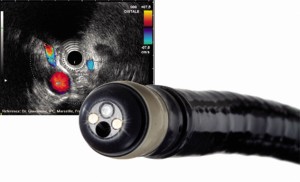By Gastroenterology Associates of S.W. Florida, P.A. –


EUS allows for assessment of submucosal lesions, staging of various cancers including esophageal, stomach, rectal, and pancreaticobiliary. It can aid in assessing the depth of penetration of a particular lesion, thus providing important information regarding staging of a potential malignancy. This can have further ramifications on therapy of a malignant lesion. With increasing use of CT scans there has been an in increased finding of pancreatic cysts. These are fluid filled cavities located within the pancreas.
These lesions may be benign though malignant transformation can occur. A special needle can be inserted through the instrument and into the cyst to aspirate its contents. Cystic contents analysis allows for plan of care to be carried out. These cysts, even if benign, should have yearly ultrasonagraphic surveillance to assess for any change in size or morphology. Submucosal lesions represent nodules or bumps that have overlying normal intestinal lining but may be of concern depending on size and layer of origin. EUS allows the gastroenterologist to evaluate the depth (layer of origin)of these particular lesions as well as their size and endosonographic appearance which helps provide a diagnosis and course of action. Staging of various cancers including pancreatic, stomach rectal can also be performed during EUS. Determining depth and extent of invasion of various malignancies helps determine a treatment protocol.
What happens during the course of EUS?
A person is sedated during the procedure and a flexible tube is inserted into the mouth or rectum of the patient. Depending on the indications, the procedure lasts anywhere from 30 minutes to one hour.
The risks of the procedure include perforation and bleeding, both of which are very rare. The patient usually goes home the same day.
Even though EUS is a relatively new technology in the field of gastroenterology it is continually evolving and reaching the status of other reliable diagnostic tools.
www.giaswfl.com | 239.275.8882
 Southwest Florida's Health and Wellness Magazine Health and Wellness Articles
Southwest Florida's Health and Wellness Magazine Health and Wellness Articles

